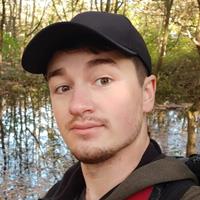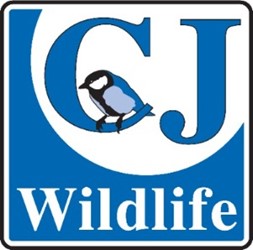For the past 2 years now The Cameron Bespolka Trust has awarded a scholarship for one young British ornithologist to attend a young birders event at the Cornell Lab of Ornithology in Ithaca, New York state. For the first time in 2016, Hampshire’s very own Amy Hall jetted off on this once in a life time trip followed by Essex’s Max Hellicar in 2017 and on the 10th of April whilst out on a morning stroll with my partner, the news came through that’d been awarded this year’s scholarship. Eureka!
The event which is held between July 12th and July 15th was created by the staff at the lab with the aims to not only bring teenagers across the planet with a deep-rooted passion for birds together, but, to also inspire and help those to pursue a career in the field of Ornithology. To help make this happen then Cornell’s top people would be on hand: Chris Wood (Assistant Director of Information Science), Jess Barry (Program Manager for the Macaulay Library) and Ian Davis (eBird Project Coordinator) to name but a few. It was an utter privilege to be at this year’s camp and words just don’t do justice for how incredible the days here were spent; but anyway, let’s get on with the show…
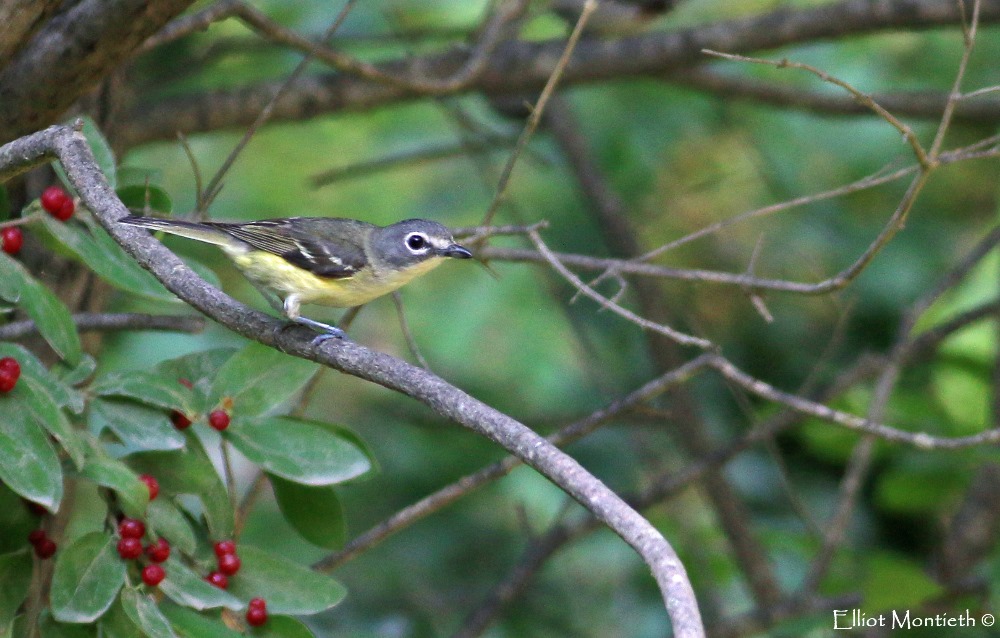
Blue-headed Vireo. Photo: Elliot Montieth
July 12th:
Following an early arrive into Ithaca, I was met at the hotel airport by no other than Chris Wood who took me out for a tour of the town before shortly heading off for a mornings birding round Cayuga Lake. Having only visited the states once before on a trip to San Francisco, the birding here for me with some of the yanks finest Birder’s was going to be a major highlight for me. In the few hours birding we got done before we had to get back to meet the other young birders who’d come from all over the globe: China, Canada, Japan, India and the Bahamas. Chris and I managed a grand total of 69 species!
The bulk of the species came from the local wetlands called Montezuma, an area of state owned land which spans 9,809 acres and holds host to a whole multitude of species all year round. If anyone plans to visit the area, make sure you fit this place in! Whilst here with Chris the species we encountered ranged from likes of Purple Martin, Tree Swallow, Bank Swallow and Northern Rough-winged Swallow darting over our heads. To Willow Flycatcher, American Yellow Warbler, Warbling Vireo and ‘Yellow-shafted’ Northern Flicker dotted about in the woodland; Least Bittern, Great Blue Heron, Great Egret and American Bittern over the marshes with Caspian Tern, Sandhill Crane, Greater Yellowlegs, Least Sandpiper, Trumpeter Swan and Blue-winged Teal all located on the pools. Keeping an eye on all the action was well, a shed load of raptors with no less than five Bald Eagle roaming around, Cooper’s Hawk, Red-tailed Hawk, Northern Harrier and an incredible number of Western Osprey – 41!
The sheer quantity and quality of avifauna was simply surreal, where else could you have a pair of Northern Harrier, seven Western Osprey, eight Caspian Tern, six Trumpeter Swan, Green Heron, countless Great Blue Heron and Great Egret all in the same scope view?! Spoilers…looks like alba and egretta are going to be up for a split in the future (American Egret…?) and in a new field coming up for the states which is currently being worked on by Chris, American Herring Gull is going to be re-named to something a bit more tasty.
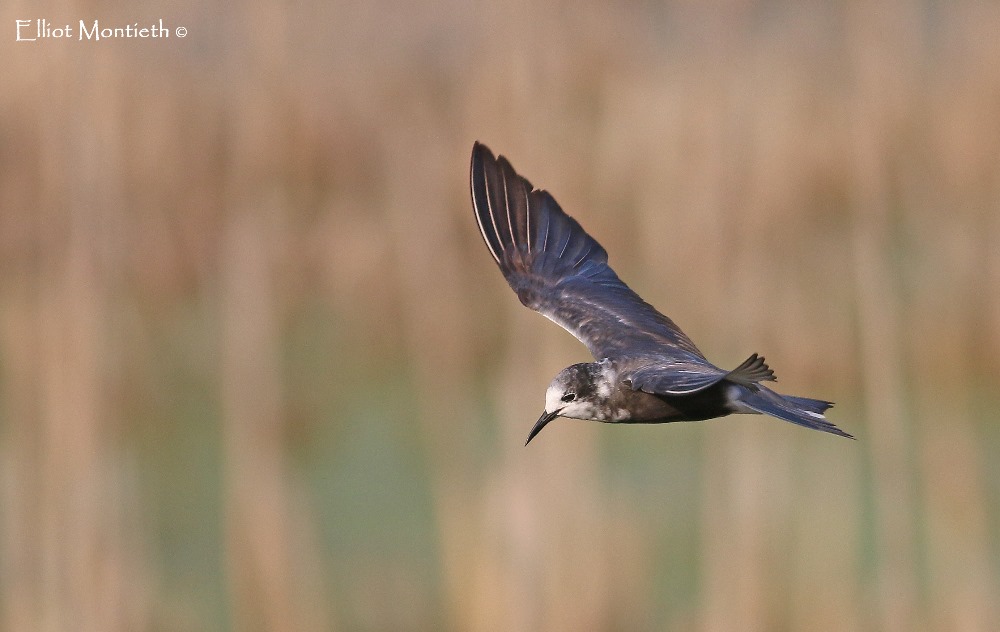
'American' Black Tern. Photo: Elliot Montieth
Shortly before heading to lunch and then off back to the Lab to meet the other 17 young birders, Chris took me up the road to Lott Farm to see something rather special, Upland Sandpiper! Bartram‘s Sandpiper, Upland Plover, Papabotte…whatever you want to call it this is one pretty mad looking wader; infact fewer than 20 breed in New York state and as is the story with virtually all Scolopacidae, they’re in decline. Whilst on route Chris informed me that there’d been no sighting of this regular pair, the most reliable pair in the state, for several weeks. So, when we arrived and I picked up not one, not two but three Upland Sandpiper and even better all were juveniles, I was fairly chuffed as I’d proven that they must have bred at this site, great news for the area.
Back at the lab, Chris introduced me to the other young birder’s I’d be with for the event: Baxter Beamer, Miles Buddy and Aaron Evans to name a few of the folk who’d come from across the planet to take part in the event. I wasn’t expecting this, such a diverse array of next generation ornithologists from every background imaginable all being united under the roof of the Cornell Lab of Ornithology with no barriers, it’s something really tremendous.
After our introductions at the Lab we headed straight into our first talk by no other than Kyle Horton, a Rose postdoctoral fellow of the lab who’s been studying bird migration across the North American continent via radars. I’ve found it hard to put it into words but in layman’s terms the Cornell folk, thanks to Kyle, can now give up to a weeks forecast of where bird falls will occur in relation to weather patterns. In addition to this, Kyle and the lab are able to see where birds congregate on migration in relation to cities and the affects that artificial lighting has on avian migration. The sheer scale of this project is just the tip of the iceberg of what Cornell is doing and to try and put it into scale I’ve attached a diagram below to show what all that data looks like.
After Kyle’s quality talk which took everyone’s breath away (he was one of many speaker’s who gave light on what possible paths we could go on following our education), we were met by Ambassador’s of Zeiss who handed out a load of goodies including a free set of bins (Oooo) and that was pretty much it for the first day. Managed to fit in Blue Jay, Ruby-throated Hummingbird, Monarch Butterfly, Racoon, Pileated Woodpecker and Chimney Swift (nice to finally see the tail spikes) whilst at the lab and afterwards we headed to our overnight accommodation before it time to hit the hay as it would be a 5am wake up call.
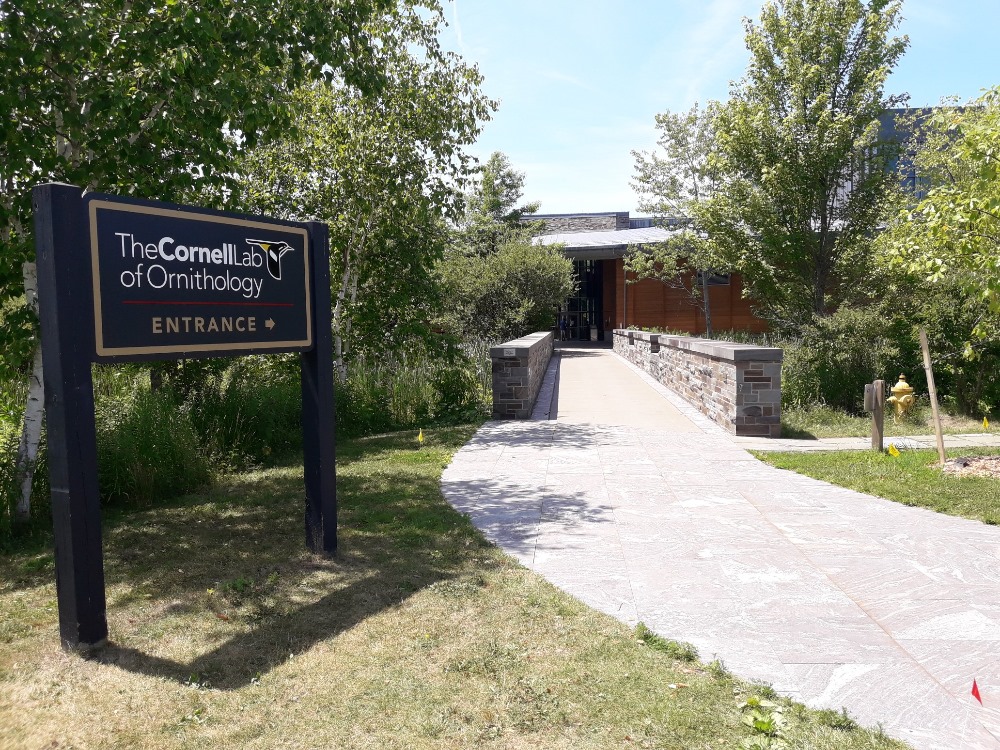
Entrance to Cornell
July 13th:
It was a new dawn, it was a new day and boy we were feeling good! Up at the crack of dawn two choices were given to us, either join Chris and Ian for some dawn birding or Jessy and some of the sound guys for an early morning sound recording. Given how priced out I was back home to even consider sound recording, an area I’ve only dreamt of getting into, I took the latter option.
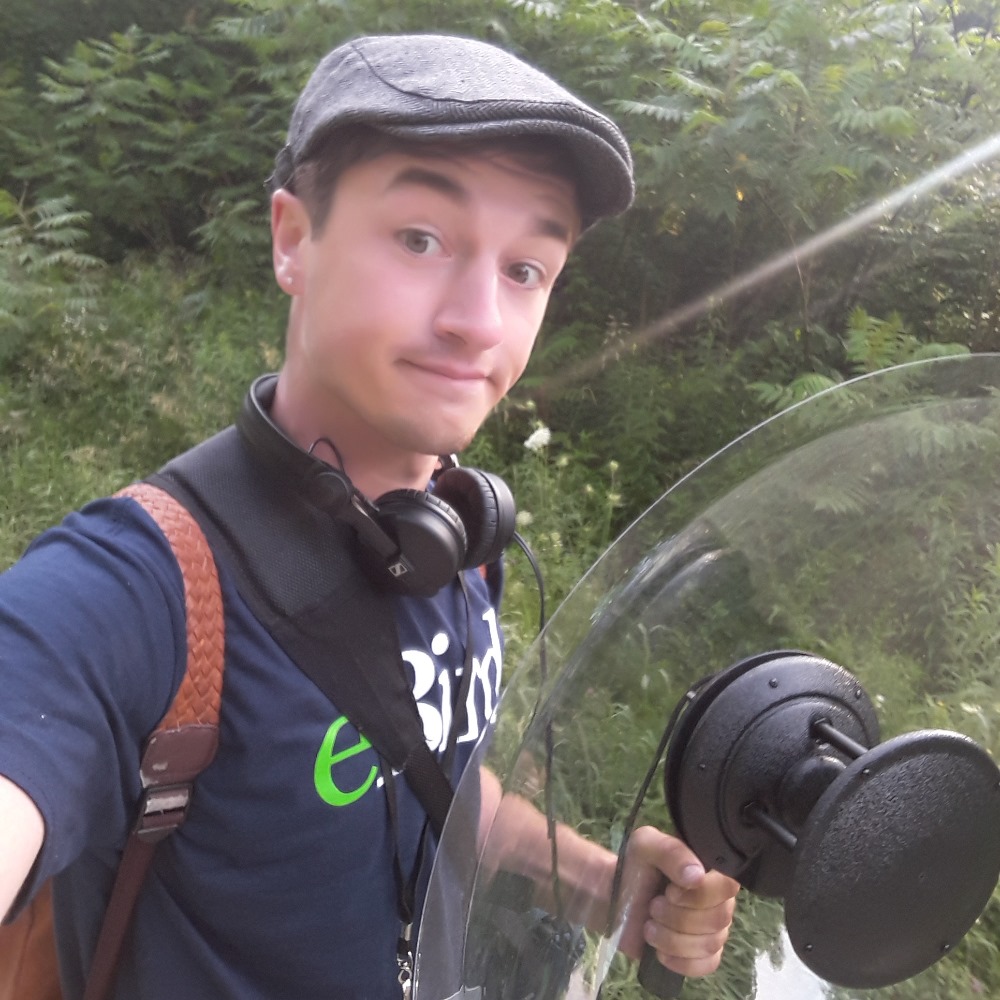
Sound recording at Cornell
Joining me in my group where Jessy Woods, Baxter Beamer and Jasper Merry and for the next several hours we’d be roaming the Sapsucker Woods documenting just about as many birds in the new world dawn chorus as we could. The equipment we’d be using included the Wildtronics Pro Mono Parabolic Microphone, Sennheiser ME 67 and Marantz PMD 661 Sound Devices MixPre3, which being able to have our hands on such a wide array of audio equipment was not only slightly mind blowing for me. But also enabled me to get to grips with the songs of previously book bound species as well as get to grips with gear that one day, I might own.
The morning duets and melodies certainly rivalled that of any I’d previously encountered back in Europe: Blackburian Warbler, Grey Catbird, Black-throated Blue Warbler, Red-eyed Vireo, Eastern Wood-pewee, Common Yellowthroat and Chestnut-sided Warbler etc. The numbers of warblers in just a small area was quite simply astounding. This was such a educational experience to familiarise myself with these gems of the new world. You can spend as much time as you want with your head stuck into field guides reading the same material in different formats over and over again. But nothing is more educational than actually being there in the flesh, in the field where there are no boundaries.
This was a truly eye-opening experience that the two groups swapped and I joined Chris and Ian for a few hours birding at a local state owned woodland, Roy H. Park. It’s a mixture of woodland habitat and if you’re not aware of the Yank ways then playback/tape luring is common practice over in the states. It’s a method that’s seen as bad field-craft over back in the Western Palearctic however there is some reason behind the seemingly mad concept of it: a wide variety of species are seen in a short space of time, as there was six in my group, if we were to just walk along the path then those at the back wouldn’t see many, if any of the species witnessed by those at the front and in areas where there is little to no data. You’re able to stop off for no more than several minutes at a site, play the tape (in this case Eastern Screech Owl with alarm call Black-capped Chickadee) and within seconds have virtually all the local species crowded around the speaker. I myself will remain playback free on my return to the British Isles, however it was interesting to encounter first-hand the differences in field of our North American friends.
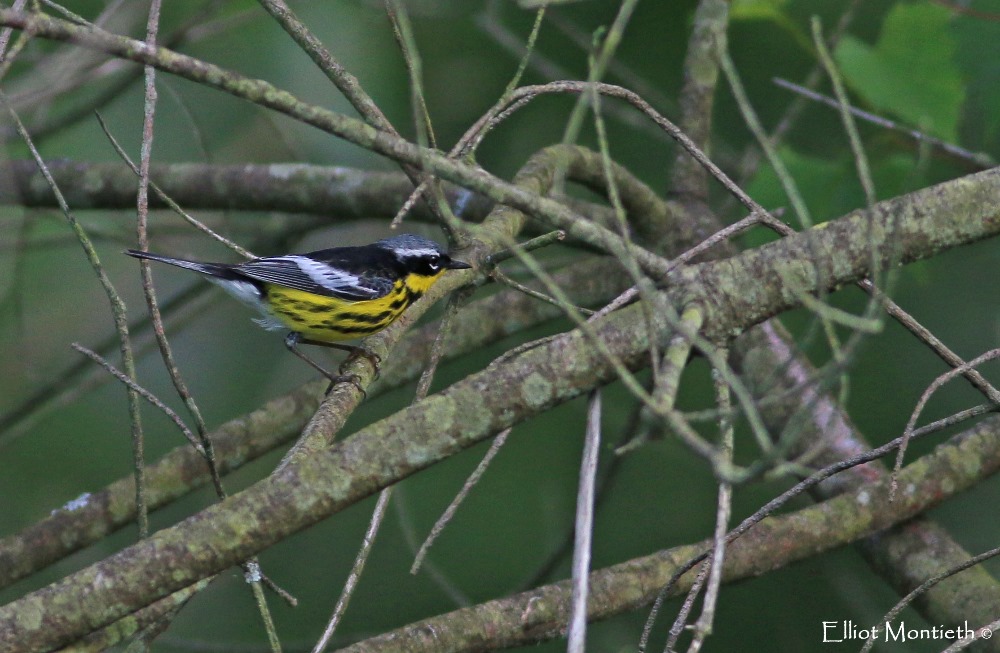
Magnolia Warbler. Photo: Elliot Montieth
On arrival at the site a pair of White-breasted Nuthatch gave fleeting views, whilst overhead Barn Swallow and a pair of Board-winged Hawk claimed the skies and topping it all off New World Warblers were seemingly everywhere. A few meters into the reserve the tape lure was played for the first time in a small conifer plantation and well, it worked to say the least: Common Yellowthroat, Chipping Sparrow, Ovenbird, Prairie Warbler, Black-billed Cuckoo and Alder Flycatcher to name but a few. A little further into the reserve and it was round two with Ceder Waxwing, Northern Flicker, Red-breasted Nuthatch, Blue-winged Warbler, Northern Parula and Indigo Bunting. Already within the first 24hrs I was racking close to 100 lifers!
A total of three hours was spent on the reserve trekking through the woodland with both Chris and Ina being excellent guides and very informative about the birds of the area, as well as the calls each one makes. Very valuable lessons to say the least such as the flight calls of Dark-eyed Junco, American Yellow Warbler, Bobolink and Song Sparrow. A grand total of 58sp where noted at Roy. H Park before we departed onto our next stop, the all mighty Montezuma. But, before we headed back to the Titchwell of New York, Chris and Ian with the rest of the gang took us to a few sites to nail what was for many of the young American birders present, a must see bird – Mourning Warbler. From what I could gather it was just a Cetti’s Warbler in drag.
After several attempts the bird was nailed, along with a few other much sort after species such as Ruby-throated Hummingbird, Scarlet Tanger, Louisiana Waterthrush and Rose-breasted Grosbeak etc. In all, yeah pretty decent mornings out in the field before heading back to the lab for lunch before an afternoon of talks before the star of the show…
John Fitzpatrick (Associate Director), Tom Schulenberg (Avian Taxonomy Specialist) and Daniel Fink (Research Associate) all gave utterly outstanding talks that truly blew out minds away. Dan and Tom’s talk did certainly open up my eyes, as I’m sure it did to everyone else in the room that no matter your skill base, no matter your background, no matter who you are; if you want to go into ornithology then you can make it, if you work for it. If anyone wish’s to apply for the Scholarship (and you’ve managed to not get bored up to this point), then I need to stress this more than I ever could. Don’t apply if you want to come over and see a load of new American species, otherwise you’re just wasting the trip. Only apply for this trip if you want to be inspired and educated; captivated by the work which the lab does so it can help you to understand and pursue the carrier path you wish your life to follow. You’ve only got one shot in life and this is a once in a lifetime trip, make it count. If you’ve got a question, ask it, they’ll answer it to the best of their ability (bare in mind these are the best people on the planet in their field) and even after the event they’ll continue to do so. Everyone there will bend over backwards to help you in whatever ways they can.
Throughout there were numerous speakers, all of which had their own angle. However, if there was one which stood out from the crowd then was ‘Birds Can Save The World’ delivered to us by no other than John Fitzpatrick (Associate Director). Straight away the title of the talk caught my eye, it wasn’t a question of birds, can they really? But it was a sign of belief and passion, fact. The underlying theme of his potent lecture was that birds change people (they saved me from myself), by understanding their populations, movements and requirements then we don’t just understand them, we see the bigger picture, the whole ecosystem. If one thing in the chain it altered then the birds will be affect and given how they’re the easiest group of organisms to study, by studying them and conserving the birds we aren’t just conserving them. But the habitat and in learn the entire ecosystem because everything relays on one another.
There’s a saying in American Conservation, “All birds of like Ducks”. Admittedly at first it’s a pretty stupid thing to say, but that’s not until you understand it. You see, following the extinction of the Passenger Pigeon, the most abundant species of bird on the planet that numbered into the billions. The next species on the list for extinction was no other than the American Wood Duck, which today you would of never have it was once on the brink of extinction. They saying above derived from the conservation efforts of this very bird; it was thanks to this efforts made to conserve this iconic species that America’s no.1 act of legislation for conservation was introduced, Migratory Bird Treaty Act of 1918. Us European’s often give the yanks a bit of a hard time over their destruction of the natural world, but credit where credit is due the Act is certainly an occasion where credit is called for. The act doesn’t just recognise that the species it’s self needs to be protected, but the environment it depends on are protected just as much as the species in question.
By the time the talks were over there was just one more thing before we could call it a day, a night in the museum tour with no other than Irby Lovette! For the two two hours we were given unrestricted access to the 58,000 specimens which the Lab held and naturally after a tour round the place, we headed to the birds! You name it, they had it: Eskimo Curlew, Two-barred/White-winged Crossbill, Crab Plover, Wandering Albatross, Snowy Owl, Least Tern, Ivory-billed Woodpecker and even a shed load of gulls…Ross’s, Sabine’s and Ivory baby!!!
Madness, disbelief and emotional is how I’m pretty sure everyone felt in the time we spent roaming the collections. To have species such as Common Ringed Plover and Semipalmated Plover aloud for surreal comparisons as did Least, ‘American’ Black and the Royal Terns. Perhaps most juicy of all was the hybrids…besides the classic Western and Glaucous-winged Gull hybrids etc. There was tray of Northern Flicker’s which they’d gathered from a recent collection trip in the central flyaway as we walked in the room. There were no samples of Northern Flicker hybridising with another species, but there was examples of interbreeding between the two subspecies that occur within the species: Yellow-shafted (Eastern America) and Red-shafted (Western America). During the last ice age, the ice sheet that covered central North America caused species pairs to form on the eastern and western coasts such as Black-headed and Rose-breasted Grosbeak (pictured) and in this case the formation of the two subspecies of Northern Flicker. Now the ice has gone, there’s a 100 mile buffer zone running through the continent which is littered with hybrids. I could go on all day, but if you want to get in touch to talk more about the talks then my contact details can be found at the bottom of the page.
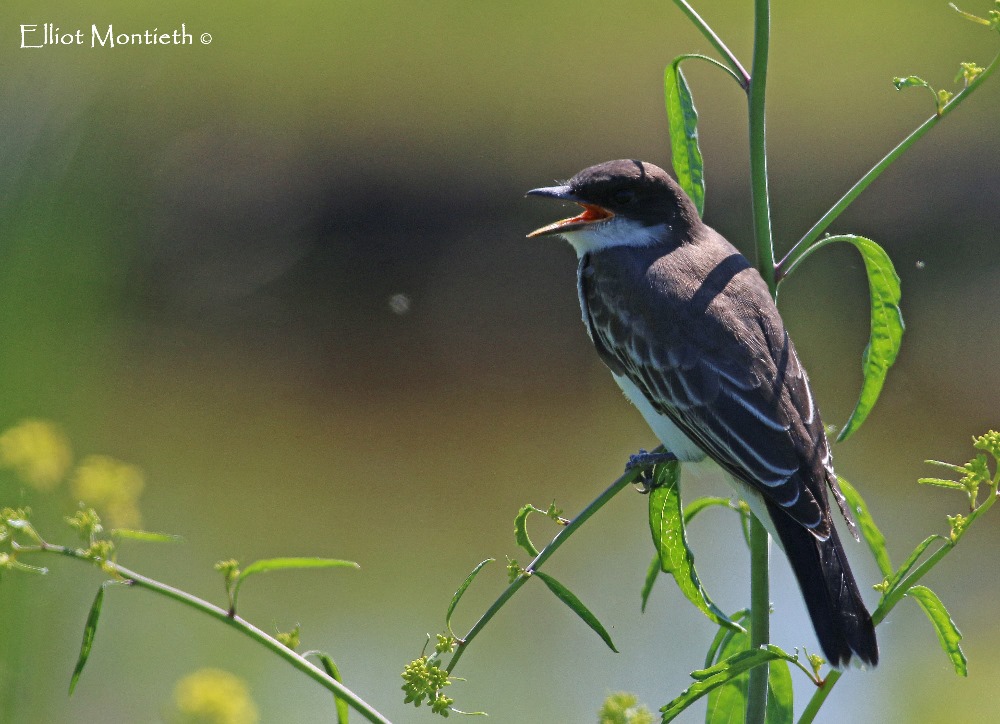
Eastern Kingbird. Photo: Elliot Montieth
July 14th:
Once again, an early wake up call with everyone up at the crack of dawn for a sunrise at no other than Montezuma. Starting at the east side of the reserve the group were greeted with views of Sandhill Crane, Bald Eagle, Northern Rough-winged Swallow, Willow Flycatcher, Bobolink, Green-winged Teal, Turkey Vulture, American Wigeon and Northern Pintail before the site’s first Louisiana Waterthrush shot over calling, probs my best find of the trip! The group was mostly half asleep so we were taken up the road to a little known place to hopefully get some improved views of Black Tern along some wetland along Van Dyne Spoor Rd.
Chris was right, we were rewarded with insane views of Black Tern, the best views of any marsh tern I’d ever encountered both in the states and back in Europe; at times they were so close that not even the cameras could focus! In addition to this the wetlands was alive: Killdeer, Solitary Sandpiper, Common Gallinule, Swamp Sparrow, American Coot, Double-crested Cormorant, Green Heron, Eastern Kingbird, Marsh Wren and Least Bittern. Here I learnt something which until this moment I’d never really thought about. Once juveniles have fledged the best in the south (Florida, Texas etc.) the likes of herons and raptors will migrate northwards to cooler climates…interesting.
Ending the day bird wise was a trip to Cayuga Lock and River Rd as new had come through that a ‘Greater’ Snow Goose (C.c. atlanticus) had shown up. It was infact an injured bird that had been shot several months before by hunters and had survived with it’s entire summer spent on the lake. It provided close views (views which back home we’d call plastic fantastic), as did a Caspian Tern, several Ring-billed Gulls and a Western Osprey.
July 15th:
The last day…
Even at this point I was still in disbelief that all this was actually happening, to me. The event, Cornell its self was absolutely fantastic and a compete privilege to of had the opportunity to attend. Not only was the birding just insanely good (144 species over three days of which 107 were lifers!), but those who’d we heard from: Professors, researcher’s and student all had an impact upon us all.
Reading between the lines, underlining everything that was spoken of, the one message I’ll always carry with me from Cornell is this – life is short. Do everything you can and if there’s an opportunity then you take it, because you don’t, then someone else will. This simple fact of life does scare people, but the more time you think about it and let it get to you the less time you have to actually get out there and make a difference.
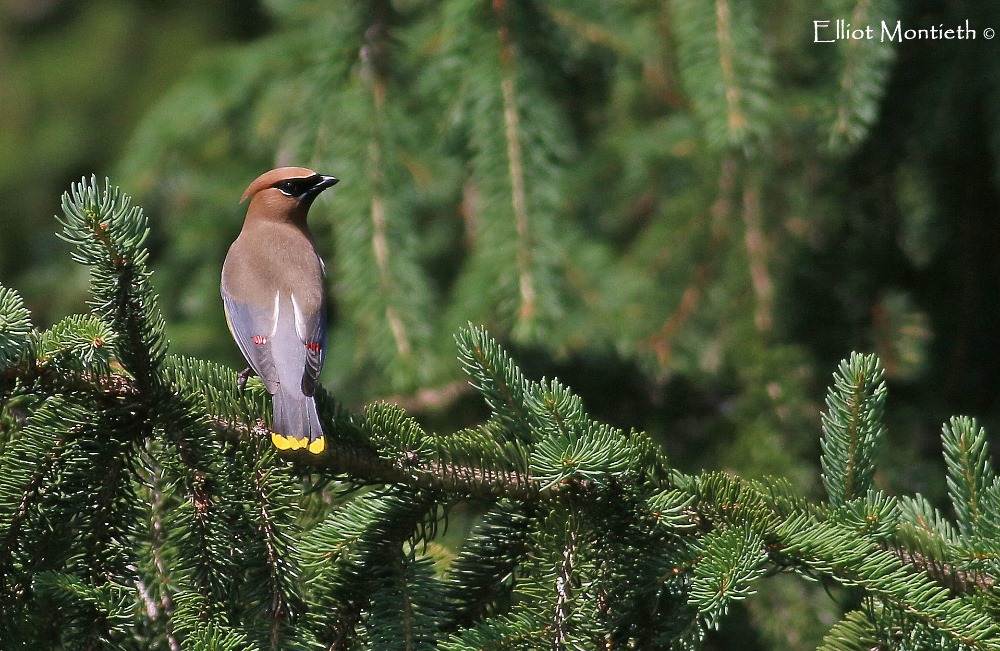
Ceder Waxwing. Photo: Elliot Montieth
My generation is a fortunate one, never before has there been so much more support for young ornithologists. The sheer quantity of events out there is simply outstanding; weather it’s the scholarship to Cornell, the BTO, HOS or RSPB Bird Camp, having access to grants such as that offered by the BTO & British Birds to allow you to travel to Bird Observatory and learn the ropes of the trade or even to help fund a project. The list goes on. There are so many opportunities out there and if there is a young birder reading this lousy report of mine, don’t be afraid to go out there and try something new. If you want help or guidance then the folk out there such as at Cornell and the BTO have an overwhelming sense of encouragement and willingness to share help in whatever way they can. All you need to do is ask. But anyway, out of the ‘deep’ and time to mention a few of the goodies we encountered on our penultimate day…
Our final day in Ithaca birding was no different from the rest, just total insanity with the first port of call being a small bog off the side of a typical country road. At first seemed lifeless but soon as the tape started playing…Virginia Rail & Sora! Pine Warbler was also about with an attempt to see Arcadian Flycatcher failing but Dark-eyed Junco and brief views of Barred Owl making up for it. Next up was some more New World warblers with Magnolia Warbler and Hooded Warbler added as were Belted Kingfisher before making our way into downtown Ithaca for ‘Taiga’ Merlin (nice tail pattern). Afterwards we went to the best site in town for Fish Crow, nailed on call (phew!) and then back to Sapsucker Woods for Northern Waterthrush and well folk that just rounds it all up as afterwards we just hit the lab and said our farewells.
If you’ve managed to read all this without dropping dead then well, you can see just what an incredible experience it was. Even sitting here now in the spare bed of Louis Driver’s house at 02:44 I’ve got a cheeky grin as this once in a lifetime trip really has opened my eyes and given me a massive boost of determination as well as clarifying what I want to do with my life.
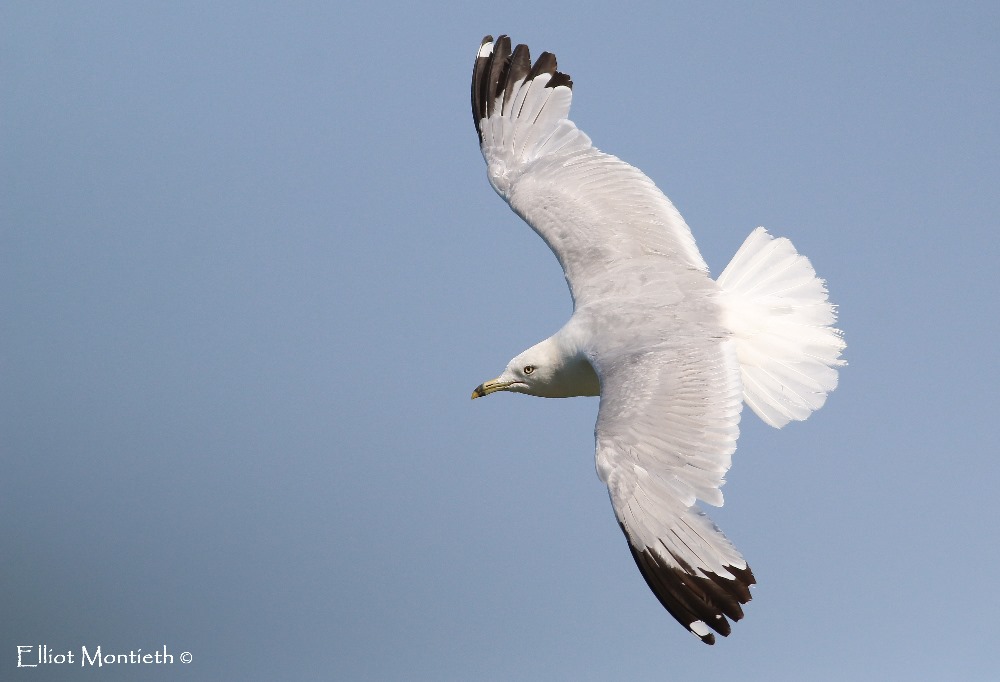
Ring-billed Gull. Photo: Elliot Montieth
The list of people to thank is just endless. For starter’s there’s everyone who I’ve mentioned from the Lab above and in particular to Jessie and Chris for housing me when my flight was cancelled. Then there’s the other young birder’s who I met, it just wouldn’t have been the same without the likes of Baxter who I learnt so much off. There is also the optics company Ziess who without their support the event might not have even been possible and well then there’s the people who made this happen, Corinne Bespolka and Keith Betton of the Cameron Bespolka Trust. Without them, I wouldn’t have gone and I have some much admiration for the work they do so to all the young ornithologists across the pond they’ve helped and back here in blightly, thank you. We salute you.
Thanks for reading,
Trip list: 144 species
- Snow Goose
- Canada Goose
- Mute Swan
- Trumpeter Swan
- Wood Duck
- Blue-winged Teal
- Gadwall
- American Wigeon
- Mallard
- Northern Pintail
- Green-winged Teal
- Redhead
- Wild Turkey
- Pied-billed Grebe
- Double Crested Cormorant
- American Bittern
- Least Bittern
- Great Blue Heron
- Great Egret
- Green Heron
- Black-crowned Night Heron
- Turkey Vulture
- Western Osprey
- Northern Harrier
- Cooper’s Hawk
- Bald Eagle
- Board-winged Hawk
- Red-tailed Hawk
- Virginia Rail
- Sora
- Common Gallinule
- American Coot
- Sandhill Crane
- Killdeer
- Upland Sandpiper
- Least Sandpiper
- American Woodcock
- Wilson’s Snipe
- Wilson’s Phalarope
- Spotted Sandpiper
- Solitary Sandpiper
- Lesser Yellowlegs
- Greater Yellowlegs
- Ring-billed Gull
- American Herring Gull
- Lesser Black-backed Gull
- Greater Black-backed Gull
- Caspian Tern
- Black Tern
- Rock Pigeon
- Mourning Dove
- Black-billed Cuckoo
- Barred Owl
- Chimney Swift
- Ruby-throated Hummingbird
- Belted Kingfisher
- Red-bellied Woodpecker
- Yellow-breasted Sapsucker
- Downy Woodpecker
- Hairy Woodpecker
- Northern Flicker
- Pileated Woodpecker
- American Kestrel
- Merlin
- Eastern Wood-pewee
- Alder Flycatcher
- Willow Flycatcher
- Least Flycatcher
- Eastern Phoebe
- Great crested Flycatcher
- Eastern Kingbird
- Yellow-throated Vireo
- Blue-headed Vireo
- Warbling Vireo
- Red-eyed Vireo
- Blue Jay
- American Crow
- Fish Crow
- Horned Lark
- Northern Rough-winged Swallow
- Purple Martin
- Tree Swallow
- Bank Swallow
- Barn Swallow
- Black-capped Chickadee
- Tufted Titmouse
- Red-breasted Nuthatch
- White-breasted Nuthatch
- Brown Creeper
- House Wren
- Winter Wren
- Marsh Wren
- Blue-grey Natcatcher
- Golden-crowned Kinglet
- Eastern Bluebird
- Veery
- Hermit Thrush
- Wood Thrush
- American Robin
- Grey Catbird
- Brown Thrasher
- Northern Mockingbird
- Euroepan Starling
- Ceder Waxwing
- Ovenbird
- Louisiana Waterthrush
- Northern Waterthrush
- Blue-winged Warbler
- Mourning Warbler
- Common Yellowthroat
- Hooded Warbler
- American Redstart
- Cerulean Warbler
- Northern Parula
- Magnolia Warbler
- Blackburnian Warbler
- American Yellow Warbler
- Chestnut-sided Warbler
- Black-throated Blue Warbler
- Pine Warbler
- Prairie Warbler
- Black-throated Green Warbler
- Canada Warbler
- Chipping Sparrow
- Field Sparrow
- Dark-eyed Junco
- Savannah Sparrow
- Song Sparrow
- Swamp Sparrow
- Eastern Towhee
- Scarlet Tanager
- Northern Cardinal
- Rose-breasted Grosbeak
- Indigo Bunting
- Bobolink
- Eastern Meadowlark
- Baltimore Oriole
- Red-winged Blackbird
- Brown-headed Cowbird
- Common Grackle
- House Finch
- Purple Finch
- American Goldfinch
- House Sparrow
